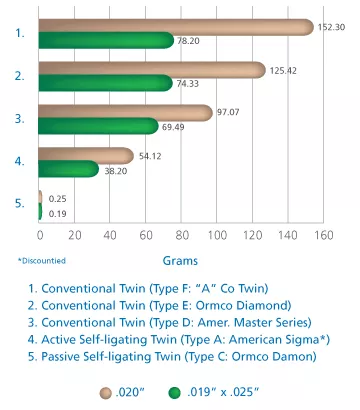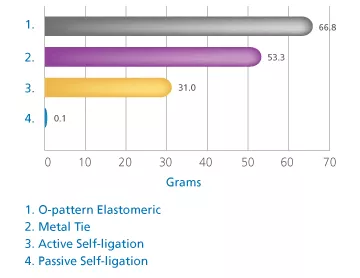Clinical Abstracts and Studies
- Frictional Forces
- Comparison of Maxillary Arch
- Self-Ligating vs. Conventional Brackets
- Damon System vs. Conventional Appliances
- Comparison of Resistance to Sliding
- Self-Ligating Treatment
- Treatment Time
- Self-Ligating in The Year 2000
- Interactive Edgewise Mechanisms
- Force Decay and Deformation
- Ligature Wires and Elastomeric Rings
Interactive Edgewise Mechanisms:
Form and Function Comparison with Conventional Edgewise Brackets
Vourdouris JC. American Journal of Orthodontics & Dentofacial Orthopedics 1997; 111:119-143.
Objective
To compare the frictional resistance of active versus passive twin bracket systems.
Methodology
A total of 83 orthodontic patients undergoing treatment with fixed appliances took part in the study. An in vivo clinical investigation with in vitro scanning electron microscopy was conducted to compare the frictional resistance of three different self-ligating bracket systems with 0.022-inch slots, active type A (Sigma*, American Orthodontics), passive type B (TwinLock*, Ormco Corp.), and passive type C (Damon™, Ormco Corp.) with three conventionally ligated twin counterparts, respectively types D, E, and F.
Results
Active self-ligating brackets demonstrate less frictional resistance than conventionally ligated twin brackets and passive self-ligating twin brackets demonstrate far less frictional resistance than active ones.
With respect to the reduction in the amount of frictional resistance for various bracket types, the following was determined:
- Active self-ligating brackets exhibited 56.7% less friction than conventional twin brackets.
- Passive self-ligating brackets exhibited 99.5% less friction than active self-ligating and 99.8% less than conventionally ligated twins.
In regard to the manner in which archwires are secured to the brackets, the following was determined:
- Elastomeric ligatures produced extremely high friction at 66.78 grams of frictional resistance.
- Metal ties produced high friction at 53.28 grams.
- Active self-ligation produced moderate friction at 31.0 grams.
- Passive self-ligation produced low friction at 0.10 to 0.18 grams.
Conclusion
"This investigation produced scientific and clinical evidence showing that interactive twins, including the Damon appliance, are capable of kinetically interacting in a non-degrading manner with resilient archwires and without elastomerics or metal ligatures to create a new reduced friction standard for biocompatible tooth movement." Furthermore, this study showed the following:
- Light clinical force application permits anchorage conservation because of low-friction properties.
- Time savings in changing archwires reduces chairside assistance time.
- Patient hygiene is significantly improved because of the reduction in the use of plaque-retentive elastomerics.
Frictional Resistance of Various Bracket Types

Frictional Resistance of Various Ligation Methods

All bracket/archwire configurations slot size: 0.022-inch slot size archwire: 0.018-inch SS